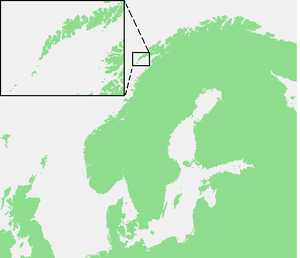
Back Operación Anklet Spanish Opération Anklet French Operazione Anklet Italian Operatie Anklet Dutch Operasjon Anklet NN Operasjon Anklet NB Operacja Anklet Polish Operation Anklet Swedish Операція «Анкліт» Ukrainian
This article has multiple issues. Please help improve it or discuss these issues on the talk page. (Learn how and when to remove these template messages)
|
| Operation Anklet | |||||||
|---|---|---|---|---|---|---|---|
| Part of the North West Europe Campaign | |||||||
 Lofoten Islands | |||||||
| |||||||
| Belligerents | |||||||
|
|
| ||||||
| Commanders and leaders | |||||||
|
Naval: Captain Hugh Dalrymple-Smith Land: Lieutenant Colonel S.S. Harrison |
| ||||||
| Strength | |||||||
|
Naval: No. 12 Commando 223 men Norwegian Company 77 men |
Eight divisions in Norway three coastal defence four infantry one Luftwaffe Field Division[1] Unknown number of aircraft and naval forces | ||||||
| Casualties and losses | |||||||
| 1 light cruiser heavily damaged |
1 patrol ship sunk 2 wireless stations destroyed | ||||||
Operation Anklet was the codename given to a British Commando raid during the Second World War. The raid on the Lofoten Islands was carried out in December 1941, by 300 men from No. 12 Commando and the Norwegian Independent Company 1. The landing party was supported by 22 ships from three navies.
At the same time, another raid was taking place in Vågsøy. This raid was Operation Archery, on 27 December 1941, and Operation Anklet was seen as a diversionary raid for this bigger raid, intended to draw away the German naval and air forces.[2]
- ^ Messenger, p.47
- ^ "No. 38342". The London Gazette. 2 July 1948. p. 3881. "Raid on military and economic objectives in the vicinity of Vaagso island"
© MMXXIII Rich X Search. We shall prevail. All rights reserved. Rich X Search